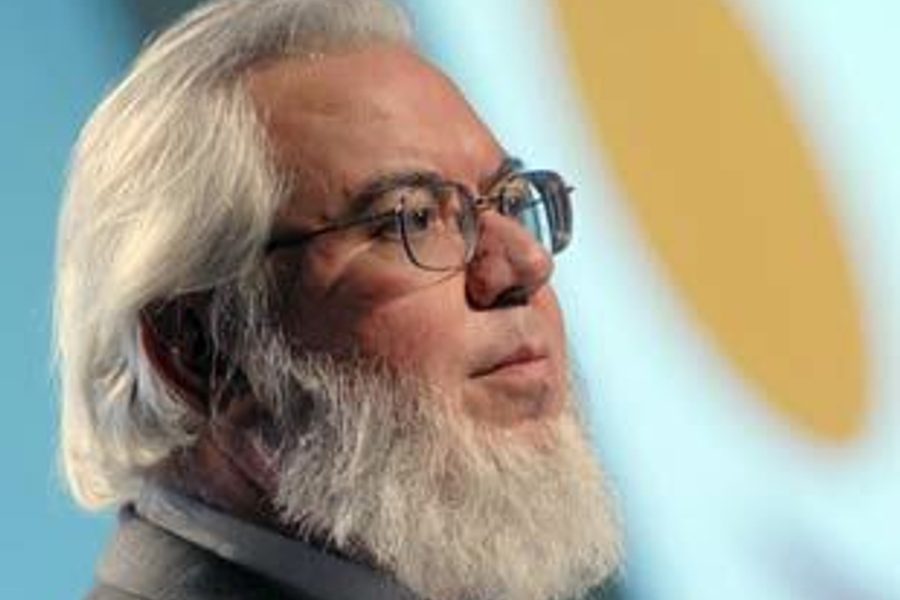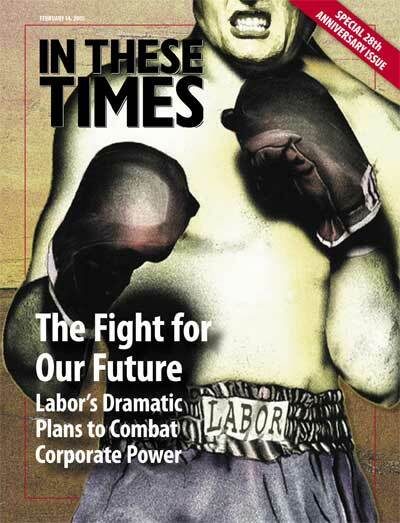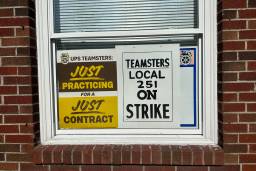
Here’s something to consider: It’s a concrete possibility we will wake up one morning and there won’t be a single American labor union left. For 30 straight years, American organized labor has been hemorrhaging members, power and influence. [Fifty years ago, 35 percent of workers belonged to unions, today just 12 percent do (and only 9 percent in the private sector).] There are already 22 states in which “right-to-work” rules effectively outlaw collective bargaining; the National Labor Relations Board, entrusted with the sacred duty of protecting the human right to organize, has been turned into just another way station for GOP corporatist hacks; and the American manufacturing sector, once the backbone of the movement, has been eviscerated by globalization.
Faced with the possibility of permanent irrelevance, different factions of the AFL-CIO have recently been engaged in a knock-down, drag-out fight over what is to be done. Despite occasional coverage in the mainstream media, this has drawn just a smattering of attention in liberal publications and the blogosphere. But progressives everywhere need to realize that they have a powerful stake in its outcome: Without the American labor movement there is no American left, and the debate taking place right now could very well determine if the movement survives.
So for those of you who’ve spent the last year following electoral politics (and subsequently sitting shiva for the republic), what follows is a guide to the key points of contention, the major players and what to expect in the months to come.
So what’s all this hubbub about the AFL-CIO possibly breaking up?
Last summer Andy Stern, president of the Service Employees International Union (SEIU), the largest and fastest-growing union in the AFL-CIO, threatened to leave the AFL-CIO unless the federation undertook drastic structural reforms — by merging smaller unions to form larger ones and strictly enforcing jurisdictional lines. The announcement caused a stir, not the least because it happened during the heat of the presidential election, when labor was supposed to be presenting a united front. After SEIU made its announcement, the International Association of Machinists and Aerospace Workers (IAM) announced that it would leave the federation if Stern got his way, so the AFL-CIO stands to lose either SEIU or the Machinists, or — if things go badly enough — both.
Stern’s announcement seems like it came out of nowhere; had SEIU hinted before that it was dissatisfied with the AFL-CIO?
Yes. The current dissension actually began back in 2003 when, as reported in these pages by David Moberg, the heads of five unions (including Stern) formed the New Unity Partnership (NUP) (see “Organize, Strategize, Revitalize,” February 16, 2004). The NUP argued that the union movement was dangerously close to extinction, and needed to make drastic changes. In a strategy memo leaked to the press, the NUP envisioned a labor movement radically altered in structure. As in the trade-union system in Europe, they proposed that each union “be assigned a unique occupation and/or and industry sector(s) to concentrate its growth efforts.” The NUP called for the AFL-CIO to sharply focus its efforts on “strategic growth,” and called on unions to devote 77 percent of their resources to recruiting new members.
How did the labor movement react to the NUP proposal?
While some hailed the NUP for its bold leadership, the proposal also triggered a backlash. Labor leaders didn’t take too kindly to five union presidents appointing themselves as labor’s saviors. Steelworkers President Leo Gerard, who derided them as “five guys sitting around and talking,” said, “They don’t represent the labor movement.”
In general, people had a hard time figuring out what exactly the five union heads — Stern, Doug McCarron of the Carpenters, Bruce Raynor of the textile workers (UNITE), John Wilhelm of the hotel workers (HERE) and Terrence O’Sullivan of the Laborers — had in common. They weren’t all the biggest unions, they weren’t in the same industry and they didn’t share the same politics: While Stern ended up endorsing Howard Dean, McCarron gave his support to Bush. Stern said they were all “radicals about growth,” but many saw it as an alliance of convenience designed to unseat AFL-CIO President John Sweeney and seize the reins of the federation.
But whatever unions thought about the merits of NUP’s proposal, it lit a fire under a labor movement that desperately needed it, and set the terms for much of the current debate about structural reform of the AFL-CIO.
What’s happening now?
In November, Sweeney sent a letter to all of the federation’s affiliates, requesting they submit a list of issues they felt must be addressed, as well as proposals for reform. So far, about a dozen unions have sent responses, with many more on the way. Both SEIU and the AFL-CIO have posted these proposals on their Web sites along with commentary from union members.
What was once just a debate about the pros and cons of the NUP platform has now morphed into a tangled landscape of proposals, alliances and rivalries (see below). The NUP has officially been disbanded because, Stern says, “We all don’t agree on our proposals.” This all comes in the lead-up to the AFL-CIO’s quadrennial convention, which will take place in Chicago in July. There have been whispers for some time that someone from the NUP coalition would challenge Sweeney for the presidency, but as of yet, no one has declared his candidacy. (For a while, Wilhem, co-president of the recently merged UNITE HERE, was rumored to be the guy, but he recently denied he’d run.)
So what does SEIU want to see happen?
The agenda is spelled out most precisely in SEIU’s 10-point plan “Unite to Win.” It features a number of suggestions that are fairly non-controversial: The labor movement should launch a campaign to unionize Wal-Mart, it should focus political energy on resuscitating enforcement of statutes that protect the right to organize, and it must build strength in regions of the country historically hostile to organized labor.
The signature proposal — inherited from the NUP, and also the most controversial — is to drastically reduce the total number of unions (from the current 58 to about 15) and to organize each of these new mega-unions around a single industry or sector. It’s not a new idea. Once upon a time, Teamsters drove trucks, United Auto Workers built cars and Steelworkers worked with steel. Today Teamsters are truck drivers, but they’re also bakers and industrial printers. Social workers in Chicago belong to the UAW and the majority of the Steelworkers don’t work with steel. This creeping “general unionism” is largely a result of the fact that as the unionized workforce has shrunk and the legal protections have been eviscerated, unions have sought to bolster their sagging numbers through mergers with other unions outside their core sectors and organizing campaigns in far-flung fields.
“Frankly, there is no rational process here,” says University of Illinois at Chicago’s Bob Bruno, associate professor at the Institute of Labor and Industrial Relations. “Everybody’s going after everyone. If you breathe and you have a job, then we’ll organize you and that hasn’t proven to be a very efficient way of doing things. It hasn’t built power and it certainly hasn’t raised class consciousness.”
Stern and others think this diffusion of worker power across various institutions, particularly within a given trade, makes it impossible to leverage industry-wide power to properly fight today’s massive global corporations. Stern points to the current labor crisis in the airline industry where unions representing pilots, flight attendants and machinists are often pitted against each other to “vote in contradiction to interests of the other workers to cut pensions.” Stern notes that “under the current system there’s no way for workers to fight back together unless the institutions they belong to are willing to band together.”
In addition to competition during contract negotiations, unions are also competing to organize the same pools of workers, particularly in the fast-growing healthcare sector, where more than 30 unions are active. SEIU notes, “In 13 of the 15 major sectors of the economy there are at least four significant unions, and in nine of those sectors there are at least six unions.”
SEIU itself has reorganized, replacing metropolitan locals with members from disparate trades with regional locals composed of members from a single industry. The union has had success leveraging this collective power within an industry to reach a kind of density “tipping point,” after which they’re able to secure representation for a large number of workers. And, as they never fail to point out, with 800,000 new members in the past eight years, SEIU is the nation’s fastest-growing union, so they must be doing something right.
That sounds like it makes sense. Why is it so controversial?
Well for one thing, fewer unions mean fewer union presidents, and leaders aren’t about to merge themselves out of a job. More substantively, it’s unclear just who gets to decide which unions merge. The idea of arranged marriages isn’t very popular. American Federation of Teachers President Edward J. McElroy put it this way in an interview with Business Week: “Making decisions about mergers is a democratic process that deals with members of unions. For any organization, the AFL-CIO or individual unions, to point a finger and say, ‘This union or that should merge,’ strikes me as totally antidemocratic. Those are the kinds of decisions individual workers should make. To say to those people, ‘This union is not functioning the way we think it should be,’ that isn’t right.”
You’ll notice that McElroy used the phrase “antidemocratic,” which, if you start reading the literature of SEIU critics, is one of the most common complaints. Those who have taken up the mantle of “union democracy” argue that SEIU’s approach, both in its own practices and in what it’s proposing, is top-down, technocratic and fundamentally inimical to the values of bottom-up representation that the labor movement should embody. They ridicule Stern for wanting to mirror the structures of the very corporations the movement is fighting (which Stern himself says is one of his aims), where directives are issued by executives and passed down the hierarchy to those at the bottom.
At a conference at Queens College last year, Gregory Junemann, President of the International Federation of Professional and Technical Engineers (IFPTE), a small, specialized union that would cease to exist under SEIU’s proposal, offered this thinly veiled critique of SEIU and its agenda: “My members are not chess pieces to be maneuvered, nor marionettes waiting to be mobilized. These are real people, and it’s their union.”
Stern says the rank and file has voted for every strategic move SEIU has pursued, but critics point out that members at locals in San Francisco and Rhode Island started decertification drives after controversial mergers backed by the International were pushed through.
In a response to a reference to “union democracy,” Stern posted the following to the SEIU’s blog:
Workers want their lives to be changed. They want strength and a voice, not some purist, intellectual, historical, mythical democracy. Workers can win when they are united, and leaders who stand in the way of change screaming “democracy” are failing to understand how workers exercise the limited power they have in a country where only 8.2 percent of the private sector are in unions.
It’s rhetoric like this that pisses a lot of people off. Gerald McEntee, president of the American Federation of State, County and Municipal Employees (AFSCME), who has a legendary beef with Stern, says “Andy put his foot in his mouth [when he spoke about AFL-CIO reform during the Democratic National Convention last summer], and I thought it was a disgrace.” Stern generally tends to inspire strong feelings among both supporters and critics. A typical anti-Stern tract on the web is titled “Why the SEIU’s Andy Stern is Full of Shit.”
So what do the unions who disagree with Stern say should be done?
It varies. The American Federation of Teachers (AFT) recommends setting up voluntary coalition bodies that can serve the purpose of industry-wide organizing while avoiding forced mergers. The Machinists say the AFL-CIO should start its own TV network to get labor’s message out, and create a centralized database of health claims to drive down costs. The Communications Workers of America (CWA) focuses its platform on making unions more responsive to their current members, increasing training for shop stewards and increasing strike capacity by providing more funds to pay striking workers (something the Steelworkers also endorse).
CWA organizer and writer Steve Early, who has probably been one of Stern’s most vocal critics, maintains that only by reinvigorating participation and militancy at the local level can the movement grow. In other words, where Stern argues that rapid growth is a necessary precondition for meaningful union democracy, Early argues that meaningful union democracy is a necessary precondition for rapid growth.
AFSCME, on the other hand, takes the position that becoming more politically effective is the key to reviving the movement. “Whether you do mergers or not, whether you reassert jurisdictional lines or not, whether you have 15 or 50 members of the Executive Committee, those things are important,” says Paul Booth, an assistant to the union’s president, Gerald McEntee. “But they don’t make as much of a difference as winning or losing in politics makes.” AFSCME wants the AFL-CIO to focus its efforts on the one thing it’s been undeniably successful at: political mobilization of its members. Under Sweeney, labor has increased turnout of union household voters in each of the last three presidential elections.
What’s clear is that while NUP and SEIU have successfully initiated and framed the debate, one that even critics such as Booth call “healthy, stimulating, appropriate and welcome,” they no longer own it.
What happens next?
In mid-February and early March, the AFL-CIO Executive Council will discuss the various proposals. In the spring, they are expected to issue recommendations, which will likely be voted on at the convention in July.
What’s going to happen at the convention is anybody’s guess. Sweeney says he’s “looking at the issues that are common in a number of these reports as potential areas where we could start early to build a consensus.” (In a 15-minute interview, Sweeney, who has the unenviable job of refereeing the impending fracas, used the word “consensus” almost a dozen times.) There are some basic agreements. The parts of the AFL-CIO constitution that are designed to enforce jurisdiction and stop unions from poaching each other’s workers are totally dysfunctional, and it is generally agreed that the AFL-CIO needs to focus its mission and play fewer roles better.
The threat of an SEIU exodus still hangs over the convention, but while many fret about the impact of a split in the house of labor, or a high-visibility, rancorous battle at the convention, the real danger is too much consensus and complacency at the cost of change. For all the enmity that the NUP and Stern have inspired, were it not for them, there would likely be no concentrated discussion about the future of the movement. Sweeney, to his credit, has lowered the temperature and quieted talk of an insurgency by moving the debate inside the AFL-CIO’s tent. But while everyone pats themselves on the back for “having the debate” and builds alliances for floor votes, the original sense of urgency is slowly being lost, replaced by quibbles about the fine points of AFL-CIO bureaucracy. “It’s converted from a debate about substance to a debate about something like the per capita tax,” says Cornell labor professor Rick Hurd.
The worst possible outcome is one that seems increasingly likely: watered-down reform, palatable to all the parties involved. That might be the only way to keep the AFL-CIO together, but keeping the AFL-CIO together is not the point. Revitalizing the labor movement is.








